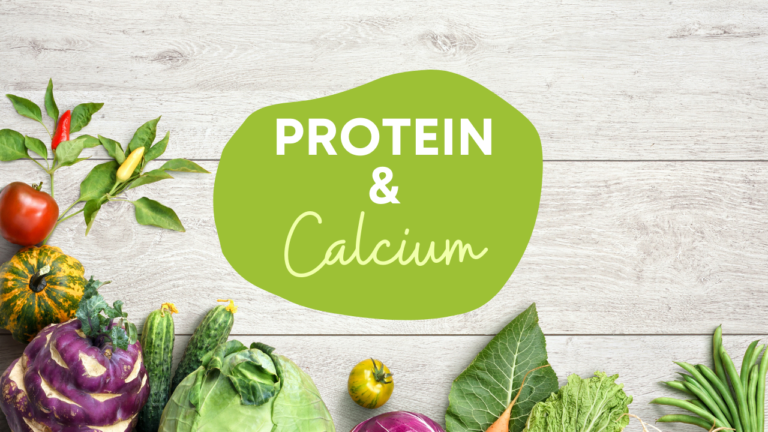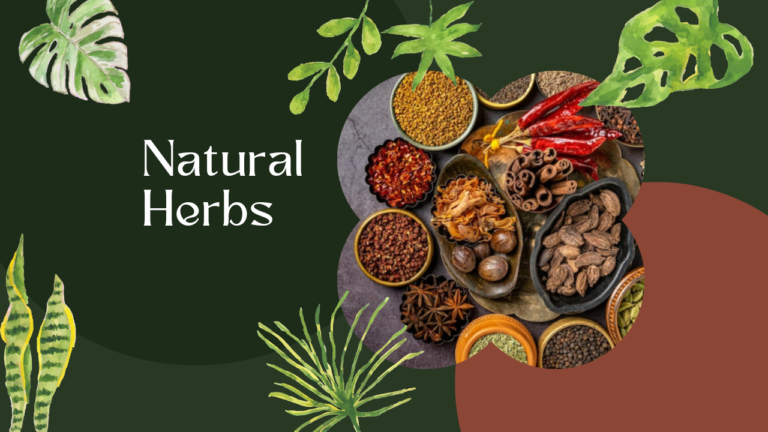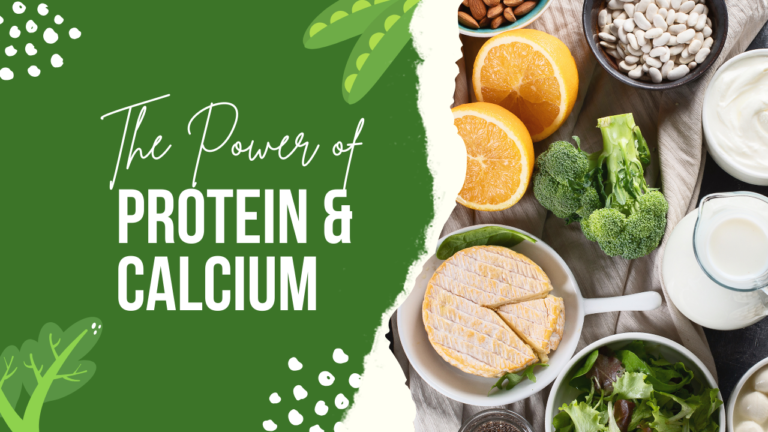GOUT AND JOINT PAIN
GOUT AND JOINT PAIN
WHAT IS JOINT PAIN?
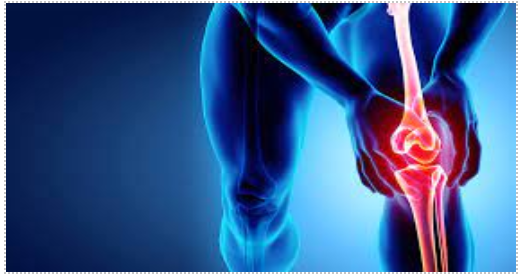
Joint pain is discomfort that affects one or more joints in your body. A joint is where the ends of two or more of your bones come together. For example, your hip joint is where your thigh bone meets your pelvis.
Joint discomfort is common and usually felt in your hands, feet, hips, knees or spine. Pain in your joints may be constant, or it can come and go. Sometimes, your joints can feel stiff, achy or sore. Some people complain of a burning, throbbing or “grating” sensation. In addition, your joints may feel stiff in the morning but loosen up and feel better with movement and activity. However, too much activity could make your pain worse.
Joint pain may affect the function of your joints and can limit your ability to do basic tasks. Severe, painful joints can interfere with your quality of life. Treatment should focus not only on pain but on getting back to daily activities and living your life to the fullest.
The most common causes of joint pain include: –
- Osteoarthritis: Osteoarthritis, a common type of arthritis, happens over time when your cartilage (the protective cushion between your bones) wears away. Your joints become painful and stiff. Osteoarthritis develops slowly and usually occurs after age 45.
- Rheumatoid arthritis (RA): RA is a chronic disease that causes swelling and pain in your joints. Often, your joints deform (usually occurring in your fingers and wrists).
- Gout: It is a type of inflammatory arthritis that causes pain and swelling in your joints, usually as flares that last for a week or two, and then resolve. Gout flares often begin in your big toe or lower limb. Gout is a painful condition where acidic crystals from your body collect in your joint, causing severe pain and swelling. This usually occurs in your big toe.
- Bursitis: Overuse causes bursitis. It’s usually found in your hip, knee, elbow or shoulder.
- Tendinitis: Tendinitis is inflammation of your tendons (the flexible bands that connect bone and muscle). It’s typically seen in your elbow, heel or shoulder. Overuse often causes Tendinitis.
- Degenerative Disc Disease: This condition affects the spine, causing changes in the intervertebral discs over time. It leads to spinal joint pain, nerve compression, and often manifests as back pain or sciatica due to pressure on nerves.
- Metabolic Disorders: Some metabolic conditions like osteoporosis or Paget’s disease can weaken bones, affecting joint health and leading to pain, fractures, or deformities.
- Genetic Factors: Certain genetic factors can predispose individuals to joint problems, such as structural abnormalities in the joints or connective tissues, contributing to increased vulnerability to joint pain and related conditions.
In addition, viral infections, rash or fever may make joint movement painful. Injuries, such as broken bones or sprains, can also cause joint pain.
Different types of Joints Pain: –
1.Knee Joint:
Knee pain is a prevalent issue that can stem from various causes, such as osteoarthritis, rheumatoid arthritis, injury (like ligament tears or strains), tendonitis, bursitis, or overuse.
– Osteoarthritis is a common reason for knee pain, characterized by the breakdown of cartilage in the joint, leading to stiffness, swelling, and discomfort.
2.Hip Joint:
Hip pain can arise from osteoarthritis, bursitis, tendonitis, labral tears, hip fractures, or referred pain from the lower back or pelvis.
– Osteoarthritis of the hip joint is a common cause of hip pain, resulting in stiffness, reduced mobility, and discomfort, particularly during weight-bearing activities.
3.Ankle Joint:
Ankle pain commonly occurs due to sprains, fractures, Achilles tendonitis, arthritis, or conditions like plantar fasciitis.
– Ankle sprains, involving the stretching or tearing of ligaments, are a frequent cause of pain, swelling, and difficulty walking.
4. Shoulder Joint:
Pain in the shoulder joint can result from conditions like rotator cuff injuries, frozen shoulder (adhesive capsulitis), shoulder dislocation, arthritis (osteoarthritis or rheumatoid arthritis), or tendon inflammation (tendonitis).
– Rotator cuff injuries, involving tears or strains in the muscles and tendons around the shoulder, often lead to pain and limited range of motion.
5. Elbow Joint:
Elbow pain can be caused by conditions such as tennis elbow (lateral epicondylitis), golfer’s elbow (medial epicondylitis), arthritis, bursitis, or fractures.
6. Wrist Joint:
Wrist pain can stem from conditions like carpal tunnel syndrome, arthritis (osteoarthritis or rheumatoid arthritis), tendonitis, sprains, or fractures.
– Carpal tunnel syndrome involves compression of the median nerve in the wrist, causing pain, numbness, tingling, and weakness in the hand and fingers.
7. Spinal Joints (Vertebrae):
Pain in the spinal joints can result from conditions such as degenerative disc disease, herniated discs, spinal stenosis, osteoarthritis, or muscle strains.
– These conditions can lead to back pain, radiating pain down the legs (sciatica), stiffness, limited mobility, and sometimes neurological symptoms if nerves are affected.
- Pain in these joints can be caused by various factors, including injury, overuse, inflammatory conditions, or degenerative changes. A proper diagnosis by a healthcare professional is crucial to determine the underlying cause and appropriate treatment for joint pain.
WHAT IS GOUT?
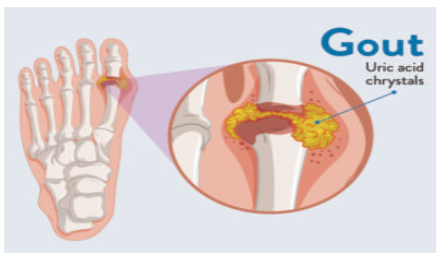
Gout is a kind of arthritis caused by a buildup of uric acid crystals in the joints. Uric acid is a breakdown product of purines that are part of many foods we eat. An abnormality in handling uric acid and crystallization of these compounds in joints can cause attacks of painful arthritis, kidney stones, and blockage of the kidney filtering tubules with uric acid crystals, leading to kidney failure. Gout has the unique distinction of being one of the most frequently recorded medical illnesses throughout.
Key aspects of gout include:
1.Urate Crystal Buildup: Gout develops when there’s an excess of uric acid in the bloodstream, a condition known as hyperuricemia. When uric acid levels become too high, the body can’t eliminate it efficiently. This excess uric acid forms crystals, typically in joints and surrounding tissues.
2.Acute Flare-ups: The onset of gout is often sudden and intense. Attacks, also known as flares, can occur unexpectedly and cause excruciating pain, swelling, redness, and warmth in the affected joint. These flare-ups might last a few days to a week or longer.
3.Commonly Affected Joints: While the big toe is frequently affected, gout can also impact other joints such as ankles, knees, elbows, wrists, and fingers.
4.Triggers: Certain factors can trigger gout attacks, including:
i. Diet: Consuming foods high in purines (like red meat, seafood, and alcohol), High Fructose corn syrup can increase uric acid levels.
ii. Obesity: Being overweight can lead to higher uric acid levels and an increased risk of gout.
iii. Medical Conditions: Conditions like high blood pressure, diabetes, kidney disease, and metabolic syndrome can elevate uric acid levels and predispose individuals to gout.
5.Chronic Gout: Without proper management, gout can become a chronic condition. Over time, frequent gout attacks can lead to repeated pain and inflammation.
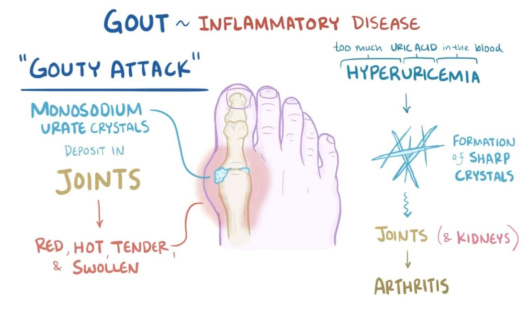
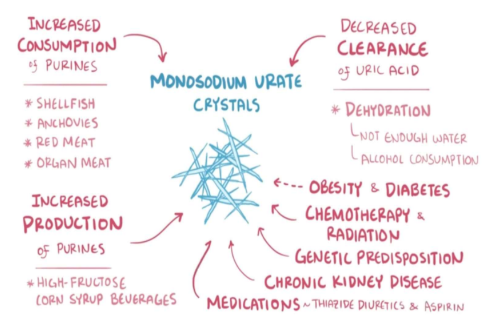
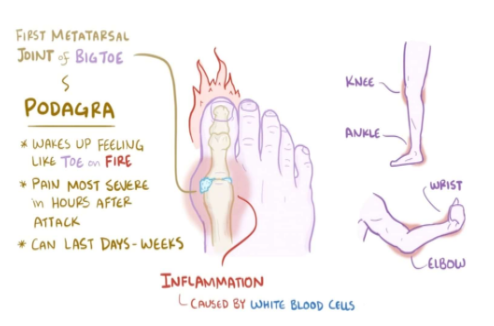
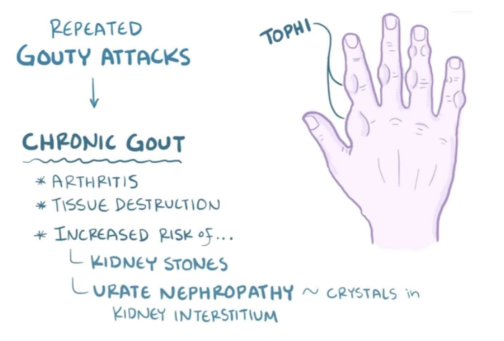
DIFFERENCE BETWEEN GOUT AND JOINT PAIN
Here are the key differences between joint pain in general and gout:-
Causes:
- Joint Pain: Can be caused by a wide range of factors, including injuries, overuse, arthritis (osteoarthritis, rheumatoid arthritis), strains, sprains, infections, or other medical conditions affecting the joints.
- Gout: Specifically caused by the accumulation of urate crystals in the joint due to high levels of uric acid in the blood. It is a type of arthritis triggered by the crystallization of uric acid within the joint, resulting in sudden and severe attacks of pain and inflammation.
Characteristics:
- Joint Pain: Can manifest as a dull ache, soreness, stiffness, or discomfort in and around the joint. It may vary in intensity and duration based on the underlying cause.
- Gout: Typically presents sudden, intense pain, swelling, redness, and tenderness in a single joint, often the base of the big toe. Gout attacks can be excruciating and can last for days to a week or more if left untreated.
Triggers:
- Joint Pain: Can be triggered by various factors, including injuries, overuse, underlying medical conditions, or chronic degenerative changes in the joints.
- Gout: Triggers for gout attacks often include dietary factors (consumption of purine-rich foods like red meat, seafood, and alcohol), obesity, certain medications, and underlying health conditions contributing to elevated uric acid levels.
Pain: Joint pain is characterized by discomfort, soreness, or aching sensations in one or more joints. The pain may vary in intensity, from mild to severe.
Symptoms of joint pain: –
- Swelling: Swelling around the affected joint(s) may occur due to inflammation, leading to visible enlargement and discomfort.
- Stiffness: Joints affected by pain may feel stiff, especially after periods of rest or inactivity. This stiffness can improve with movement.
- Redness and Warmth: Inflammation in the joint can cause the skin over the affected area to appear red and feel warm to the touch.
- Limited Range of Motion: Joint pain can lead to difficulty in moving the joint freely, resulting in reduced flexibility and mobility.
- Weakness: Muscles around the affected joint might feel weak due to pain or restricted movement, leading to reduced strength in that area.
Symptoms of Gout:
- Sudden and Intense Pain: Gout typically manifests as an acute attack of severe pain, often occurring suddenly, commonly in the base of the big toe. The pain can be excruciating and debilitating.
- Swelling and Redness: The affected joint becomes swollen, inflamed, and may appear red or purplish due to the accumulation of urate crystals.
- Tenderness and Warmth: The joint affected by gout becomes extremely tender to the touch, and the skin around the joint may feel warm.
- Limited Range of Motion: Due to severe pain and swelling, movement of the affected joint becomes restricted, making it difficult to walk or use the joint normally.
- Duration of Attacks: Gout attacks typically last for several days to a week or more, gradually subsiding without treatment.
- Recurrent Episodes: Individuals with gout often experience recurrent attacks, with periods of time between attacks where they are symptom-free.
Common tests to diagnose and evaluate conditions like Gout, Arthritis, and joint pain:-
1.Blood Tests:
- i. Uric Acid Levels: Elevated levels of uric acid in the blood can indicate
- C-Reactive Protein (CRP) and Erythrocyte Sedimentation Rate (ESR): These tests measure inflammation in the body and may help in diagnosing arthritis.
2.Joint Aspiration (Arthrocentesis):
- i. Synovial Fluid Analysis: Fluid from an affected joint is removed and analyzed for crystals, which could indicate It can also help identify infection or inflammation.
3.Imaging Studies:
- i. X-rays: To visualize the bones and detect joint damage associated with arthritis.
- MRI (Magnetic Resonance Imaging) or CT (Computed Tomography) Scans: These provide more detailed images of the joints and surrounding structures.
4.Joint Ultrasound: To check for signs of inflammation or damage to the joints.
5.Hematological Tests:
- i. Complete Blood Count (CBC): Can reveal abnormalities, such as anemia, which may be associated with certain types of arthritis.
6.Genetic Tests: For certain types of arthritis like rheumatoid arthritis, genetic tests may be considered to assess susceptibility.
7.Physical Examination: Clinical evaluation by a healthcare professional to assess joint pain, swelling, and range of motion.
NATUROPATHY TREATMENTS: –
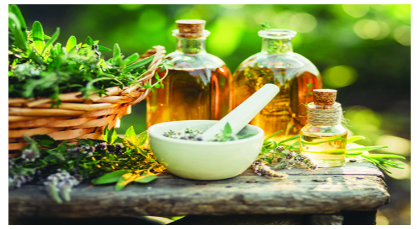
1.Fasting: In naturopathy, Fasting is the best medicine for any disease.
2.Dietary Changes:
- i. Anti-Inflammatory Diet: Emphasize foods that have anti-inflammatory properties, such as fruits, vegetables, whole grains, fatty fish, and nuts.
- Limit Purine-rich Foods: Gout is associated with high levels of uric acid, and limiting foods high in purines (e.g. Alcohol, Red meat, shellfish, mushroom, green peas, Broccoli, sprouts, Cauliflower etc.) may be beneficial.
3.Herbal Remedies:
- i. Turmeric and Ginger: These herbs have anti-inflammatory properties and may help reduce joint pain.
- Methi Seeds: Known for its anti-inflammatory effects, it may help manage arthritis symptoms.
4.Supplements:
- i. Omega-3 Fatty Acids: Found in fish oil, flaxseeds, and chia seeds, these may help reduce inflammation.
- Vitamin D and Calcium: Important for bone health and may be beneficial for arthritis patients.
5.Hydrotherapy:
Warm Baths: Soaking in warm water may help relax muscles and joints, providing relief from pain.
6.Acupressure: Acupressure can help alleviate pain and improve overall well-being.
7.Physical Activity:
Low-Impact Exercise: Activities like swimming and walking can help maintain joint function without putting excessive stress on the joints.
8.Stress Management:
Yoga and Meditation: These practices along with fresh air may help manage stress, which can contribute to pain and inflammation.
9.Lifestyle Changes:
Weight Management: Maintaining a healthy weight can reduce the strain on joints, especially for individuals with arthritis.
IMPORTANT POINTS TO NOTE: –
- Fasting – Fasting for 3 to 5 days on orange juice and water can help with joint pain.
- Cherry – Ludwig W Blan (Phd) discovered that eating Cherry helps reduce Gout problem. Start with 25 cherries a day for 15 to 20 days, thereafter 10 cherries a day will keep the ailment under control.
- Juice – Carrot juice 300 ml, Beet root and Cucumber juice 100 ml each. This 500ml juice needs to be consumed each day.
– Juice of French or string beans has also proved effective in the treatment of gout.
- Potassium rich food – Potato, Banana, Green leafy vegetables, Beans etc.
- Epsom salt Bath – Hot Epsom water Feet bath or full body bath helps in managing pain (never put hot water over the head).



